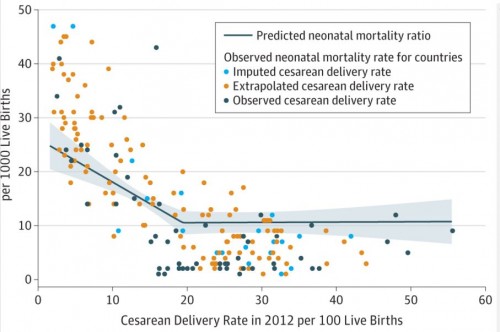It’s like a parable for all healthcare. From JAMA, “Relationship Between Cesarean Delivery Rate and Maternal and Neonatal Mortality“:
Importance Based on older analyses, the World Health Organization (WHO) recommends that cesarean delivery rates should not exceed 10 to 15 per 100 live births to optimize maternal and neonatal outcomes.
Objectives To estimate the contemporary relationship between national levels of cesarean delivery and maternal and neonatal mortality.
Design, Setting, and Participants Cross-sectional, ecological study estimating annual cesarean delivery rates from data collected during 2005 to 2012 for all 194 WHO member states. The year of analysis was 2012. Cesarean delivery rates were available for 54 countries for 2012. For the 118 countries for which 2012 data were not available, the 2012 cesarean delivery rate was imputed from other years. For the 22 countries for which no cesarean rate data were available, the rate was imputed from total health expenditure per capita, fertility rate, life expectancy, percent of urban population, and geographic region.
Exposures Cesarean delivery rate.
Main Outcomes and Measures The relationship between population-level cesarean delivery rate and maternal mortality ratios (maternal death from pregnancy related causes during pregnancy or up to 42 days postpartum per 100 000 live births) or neonatal mortality rates (neonatal mortality before age 28 days per 1000 live births).
What’s the relationship between c-section rates and maternal mortality? What’s the relationship with neonatal mortality? This is a big study of 194 countries who are WHO member states. Let’s look at maternal mortality first:
Countries with low rates of c-section have a high maternal mortality rate. As rates increase, maternal mortality drops. That is, until about 19%, when benefits appear to level off. How about infant mortality?
Very similar results. Improvements in infant mortality until about 19%, with less of an impact after that.
So, absolutely, countries with low rates of c-section should likely work to make it more available. In the US, though, we have a c-section rate of almost 33%, way past the point where more seems correlated with a benefit. Worse, both the infant and maternal mortality rates in the US are terrible. So… what are all those c-sections for?
Many areas of the world need more; we appear to have too much.


